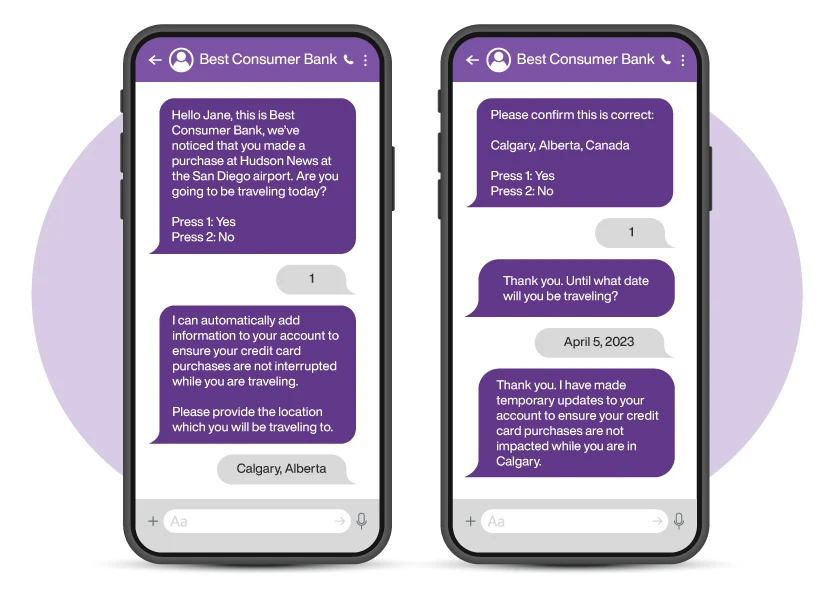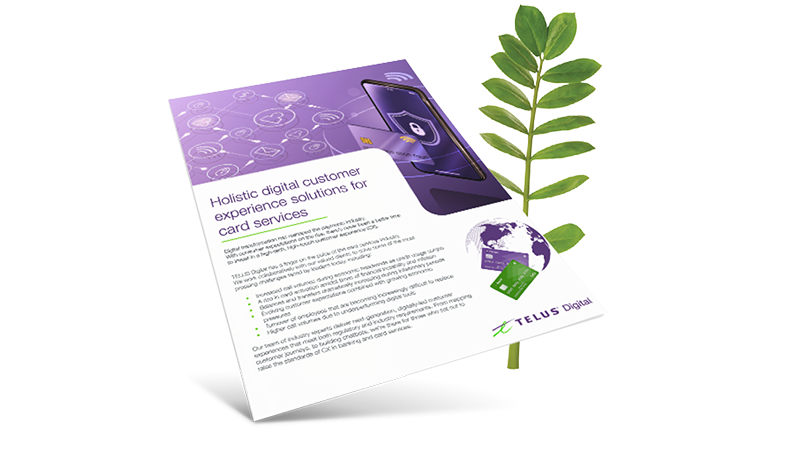Going beyond transactions: How card brands can offer elite digital CX

Digital transformation has been a disruptive force in the card services industry. As have the current economic conditions, which have heightened the demand for cash alternatives around the world. According to Clearly Payments, there are 15 billion payment cards globally and the amount that people spend on credit is on the rise. Over $3 trillion is spent annually in North America alone, an amount estimated to be increasing by roughly 10% each year.
As consumer demand and expectations continue to rise, card services brands should focus on delivering personalized, convenient experiences for their customers in order to remain competitive and build customer loyalty.
Offering a great card services customer experience
Competition is growing increasingly fierce in the card services industry with new entrants featuring unique value-based propositions joining the scene. Companies that are looking to capture market share and build consumer trust should look to enhancing the customer experience (CX) as an essential piece of the puzzle. In fact, according to Alyson Clarke, principal analyst at Forrester, "Improving CX goes straight to the bottom line. For a large multichannel bank, a 1-point improvement in its CX Index score can lead to an incremental $123 million in revenue."
Delighting customers and keeping them coming back for more comes down to one winning combination: digital automation and human engagement.
Digital CX tools that pay dividends
Digital customer experience tools help to streamline customer service interactions, solving problems quickly and effortlessly. The value of these tools has not gone unnoticed by business leaders. According to a survey by TELUS Digital in partnership with Statista, 72% of executives said they are planning to increase their digital customer experience budgets in 2023. Here's a look at three popular digital solutions card services brands can leverage to optimize their processes and enhance their CX.
1. Robotic Process Automation (RPA)
Robotic process automation is the use of a computer to replicate human actions to streamline processes. Tasks that are mimicked by RPA are rule-based, repeatable and easy to transact.
The benefits of RPA: Serving as a type of "digital co-worker," RPA is able to handle repetitive and time-consuming tasks thereby freeing up human employees to support more complex and nuanced work. Additionally, RPA can improve accuracy and consistency with around-the-clock availability, providing great speed and efficiency.
RPA use case: As the demand for credit cards increases, RPA can be used to help companies scale their operations by significantly reducing the time and resources needed to process applications. Data entry and validation can be automated along with credit and background checks. Applications can be automatically approved based on predetermined criteria and RPA bots can read account data and suggest credit card limit increases seamlessly.
2. Fraud analytics
With fraud analytics, credit card companies mine data for patterns and irregularities that are then translated into insights. This analysis is used to identify false transactions, find instances of money laundering, assign fraud risk scores and more.
The benefits of fraud analytics: Fraud analytics can identify and flag suspicious activity in real-time. Additionally, by leveraging machine learning (ML) and artificial intelligence (AI), fraud analytics can continuously learn and adapt to new fraud schemes, improving accuracy and reducing false positives. Ultimately, the use of fraud analytics can help businesses to maintain the integrity of their operations, protect their customers and safeguard their reputation, leading to increased customer trust and loyalty.
Fraud analytics use case: When a purchase is made using a credit card, analytics can be used to detect any sort of anomaly. If an anomaly exists, the transaction can be held and a request for secondary validation can be automatically triggered to the card user. For example, if a customer attempts to purchases a television, a secure SMS can be sent to a user's trusted device asking if they are making the transaction, with response options of 'Y' or 'N.' If the user confirms they are in fact purchasing the television, they text 'Y' and the transaction is released. If the user responds with 'N' the transaction is automatically reported as fraudulent and is not completed.
3. Intelligent automation
Intelligent automation combines RPA with advanced AI technologies such as machine learning, natural language processing (NLP) and computer vision (CV) to automate complex tasks and processes that require cognitive abilities. Applications that use intelligent automation can analyze data and make decisions based on that analysis to operate in unstructured environments. Additionally, these systems are able to learn and improve over time.
The benefits of intelligent automation: The advantages provided by intelligent automation are varied and can impact both the internal operations of a business as well as its customer experience. Intelligent automation takes the speed, accuracy and cost savings benefits of RPA to the next level, further enabling workers to focus on higher-value tasks and improving productivity and processing times. Intelligent automation solutions like AI-enabled chatbots can also help to reduce inbound call volumes with timely responses to customer inquiries. Intelligent automation also has the ability to increase sales by creating cross and up-sell opportunities by notifying customers of special promotions or incentives and providing personalized recommendations for products and services that meet their needs.
Intelligent automation use case: How intelligent automation is implemented within a business greatly depends on how far along a brand is in its automation journey. Use cases can range from simple — where customers use a chatbot to assist them in making payments or checking on account balances — to the more complex. For example, intelligent automation can be used by card services brands to provide real-time monitoring of customer accounts to mitigate the risk of a card being declined when traveling out of state or country.
If a card user, for instance, makes a purchase of a magazine at an airport, the RPA system that monitors the account automatically triggers a chatbot to send a secure SMS message to the customer's trusted device asking them if they are traveling. Once travel has been confirmed by the customer, the chatbot can gather all relevant information related to the travel plans through secure messages and make temporary updates to the customer's profile to ensure their credit card purchases are not impacted.

Proactive monitoring can also be used to help offset potential inconveniences. In this instance, bots monitor credit card activity in real time and keep a record of future dates. For example, if a customer books a flight or a hotel stay, the system proactively takes note of the date of expected travel in the account and schedules an automatic secure SMS to be sent to the cardholder the day before, or day of, travel to confirm the itinerary. Once travel has been confirmed, the account is updated to ensure any credit card purchases are not impacted. As an extra touch, bots can provide personalized messages or offers for the customer to take advantage of while they are at their destination.
In both of these scenarios, updates to an account can be completed entirely through the chatbot, without having to engage a human agent, and the customer receives a streamlined, convenient experience.
The human component of customer experience
While digital tools play an integral role in developing a robust customer experience strategy, they can only get you so far. The human component of CX should not be overlooked. For your customer experience operations to truly shine, your digital tools need to work in harmony with your customer support agents.
Maya Angelou, the famous poet and civil rights activist, is commonly quoted as saying "I've learned that people will forget what you said, people will forget what you did, but people will never forget how you made them feel." This perceptive observation gives us insight into why a team of highly-engaged, empathetic and capable customer service agents is so important to customer satisfaction.
Customers want to feel valued, respected, appreciated, happy and confident in their decision-making. How your agents make customers feel after an interaction can mean the difference between long-term loyalty and a short-term relationship. In fact, in its US 2022 Customer Experience Index, Forrester found that emotion continues to be a key driver for delivering high levels of CX performance and is the number one driver of brand loyalty.
When payment problems or other account concerns arise, and emotions are likely to be high, it is critical that customers are able to quickly and easily speak to an agent who is able to address their concerns empathetically. Ensuring that your team has received the proper training in order to exhibit a deep understanding of your company's products and services is essential to providing timely and accurate resolutions. Additionally, a strong corporate culture that fosters high employee engagement and long tenure plays an integral role in creating highly-effective customer support teams.
As the demand for cash alternatives continues to rise, card services brands would be wise to partner with a knowledgeable customer experience provider that has access to the digital customer experience solutions and engaged workforce required to offer a hybrid approach to CX that will delight consumers and foster loyalty.



